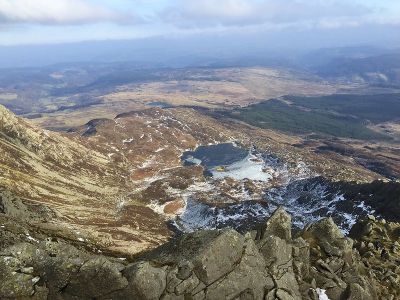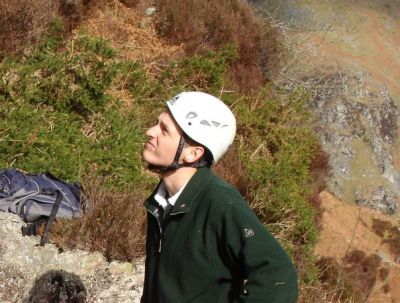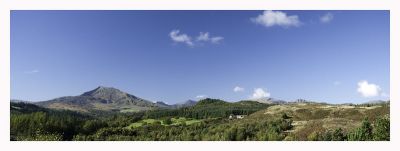A classic from Capel Curig: Moel Siabod
The perfect walk for those who don't like climbing
Cadair Idris is a wonderful mountain. A true spectacle comprising rugged ridges and steep ascents, with a shimmering glacial lake at its heart. A walk here is an unforgettable experience.
Or so I’ve been told. I’ve never actually been there.
I have been to Eryri / Snowdonia many times and for myriad reasons – trips with friends, family holidays, a fundraising walk, Duke of Edinburgh expeditions – and have always ended up in its northernmost reaches. Usually, I try to see as much of a region as possible. I have walked in each of main fell groups in the Lakes, for example, and explored many different parts of Scotland. But apart from one snowy trip to the Rhinogs, I have spent all my time in north Wales in just one corner.
The obvious explanation is that this is where Wales’ biggest peaks lie – the fourteen 3,000-footers that comprise Yr Wyddfa, the Glyders and the Carneddau. But this can’t be the only reason, because these are not the mountains I go to. My favourite Welsh peak is just shy of that magic (albeit arbitrary) threshold and sits across the Nant Gwyrd valley.

Yet despite lacking a few crucial metres of height, Moel Siabod has everything that a mountain walk requires. The views are unsurpassable, especially those back across to its loftier neighbours to the west. There’s a taste of the region’s industrial history to be found, with the buildings from the abandoned Rhos slate quarry situated on the way up to Llyn-y-foel. And most routes start and finish in Capel Curig, which has pubs, cafes, a campsite and hostel, plus the legendary Joe Brown outdoors shop. It's also easy to reach by public transport, with several services stopping there, including the legendary Snowdon Sherpa buses.
But Moel Siabod has an even better trick up its sleeve: Daear Ddu.
On the mountaineers’ continuum, I regard myself as an excellent walker and a terrible climber. I can read maps, lead groups and take decent(ish) photos. I can light a bothy fire, last out bad weather, and cover long distances without (too much) complaining. I have a respectable assortment of outdoor kit – there’s a kazoo and a bivvy bag lurking somewhere in the cellar – and have a thorough, if not fully complete, knowledge of the UK’s high places, accumulated over nearly four decades spent enjoying them.
But put me at the base of something sheer and rocky and that mountain know-how crumbles faster than a soggy flapjack. I become nervous, cautious, twitchy. I will usually be the one to put forward the case for attempting something easier: a walk perhaps, or maybe just straight to the pub? I have never fully mastered knots and belays, which reduces my status on climbing trips from ‘partner’ to ‘baggage’. And my upper body strength is poor, which has seen me shuffle up most routes on little more than knees and prayers.

Now, at the age of 43, I can finally admit the truth: I don’t really like climbing.
Scrambling is perfect for people like me. It gives us a fresh challenge, something to prevent the walking from becoming routine. It’s also a chance to taste the thrill that our rope-dangling comrades get each time they hit the crags. We get to scuff our hands and enjoy the sensations of shaking legs, vertigo and the freedom to swear a lot. All safe in the knowledge that nothing’s going to go wrong. Well, probably not.
Daear Ddu, the ridge on Moel Siabod’s southern side, is a scrambling paradise. It’s long and steep, but – and this is the crucial point – it’s not hard. Huge boulders provide meaty holds and the top is almost always in sight. Best of all, it’s exposed. The drops are steep on both sides and, especially looking east towards Llyn-y-foel, something special. You can imagine what it would be like to tumble down towards it, with virtually no fear of it actually happening. It’s the perfect mountain playground for those of us who like our adrenaline in small, manageable doses.
At some point, I’ll explore Eryri more completely. The Berwyns are overdue a visit, as are the Moelwyns. The western end of the Glyders are calling me to return, and especially Elider Fawr, after bad weather curtailed my attempt on the 3,000-footers at one short of the full fourteen. Cnicht demands further investigation, while there is more to do on Moel Hebog. And I have promised myself that one day, I will finally make it to Cadair Idris; it’s been high on my to-do list for almost as long as I’ve been walking.
That’s the plan, anyway. But some mountains have a strange, inexplicable hold over us. As soon as I next head west across Wales, I know exactly where my first stop will be. Moel Siabod and Daear Ddu. I need to be there again before I even think about going anywhere else.
Tim Woods is the author of Twisted Mountains, a darkly humourous collection of mountain-set short stories. You can order a copy from Little Peak Press.

Photos: Top (c) Andy Harbach / Flickr; middle (c) Gary Shipp; bottom (c) mike1105 / Flickr
